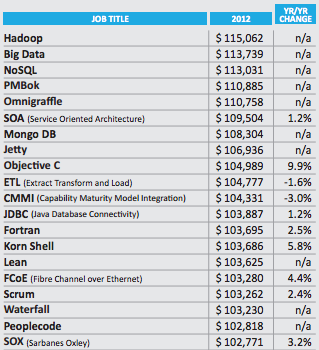
Enterprises may still not know exactly what value they expect to glean from Big Data, but that hasn’t stopped them from spending big money on Big Data skills like Hadoop and NoSQL. According to a 2013 Dice Tech Salary Survey, Hadoop and NoSQL skills, the two mainstays of Big Data projects, are worth more than any other technology skills, up to $115,062 on average, with Apple-related technologies like Omnigraffle and Objective-C not far behind.
Buried in that salary data, however, are indicators that Big Data remains far too much of a Silicon Valley science project for now.
The Big Money Is In Data
As I noted recently, enterprises are somewhat conflicted on how to make use of Big Data. When 56% of respondents struggle to know how to get value from their data yet are either deploying or planning to imminently deploy a Big Data project, we have a serious disconnect.
What we don’t have, however, is any sort of hiring freeze on Big Data professionals, as the salary data suggests:

Enterprises are clearly willing to pay a premium to find or retain good people to help make sense of their data.
They’re also paying a premium for Apple-savvy developers. Both Omnigraffle and Objective-C show up in the top-10 highest paying job skills in Dice’s survey. This is even more interesting in light of Indeed.com’s analysis of the hottest job trends. In addition to two Big Data technologies making the list, five mobile skills (HTML5, iOS, Android, mobile app, jQuery) find themselves in the top-10, only one of which is explicitly Apple-related.
HTML5 and Android match Apple in total jobs, and blow Apple away in terms of relative job listing growth:
Yet it’s Apple-related development that pays the highest salaries. And by a wide margin, given that the average mobile developer makes around $80,000, compared to Objective-C-savvy developers, who bring home $105,000.
Want More Money? Move To The Valley
It remains to be seen, however, whether both Big Data and Apple iOS-related development will be worth as much once they go truly mainstream.
After all, since 2003 the average U.S. tech salary has ballooned from $69,400 to $85,619 in 2013, including a big 5% jump in 2012. But if you want to collect an outsized paycheck (and pay an outsized mortgage), the Valley remains the land of promise. Boasting an average tech salary of $101,278, Silicon Valley is the only area with an average salary that tops $100,000, and this despite dropping 2.8% since 2012 while other metro areas like Boston (up 7% to $94,742) and Los Angeles (up 6% to $92,498) have grown strongly.
As one executive told me recently, Hadoop still requires a lot of heavy lifting to make it useful. The skills necessary for working with it remain in short supply; hence, the salary premium.
They’re also predominately based in Silicon Valley, as a Indeed.com geographical analysis shows. A huge percentage of Hadoop jobs are found in the Bay Area, with New York in a distant second and Seattle coming in a very, very distant third. The same is true of iOS jobs.
The Future Is Not Yet Evenly Distributed
While it’s great that Silicon Valley offers a Gold Rush for Big Data and Apple professionals, it’s also an indication that Big Data and mobile development haven’t truly gone mainstream. Not yet.
Which is another way of saying that the future is very, very bright for both in terms of jobs, and particularly Big Data. Eventually Android and HTML5 are likely to dilute Apple’s outsized influence on mobile, bringing down either salary levels or job numbers or both. But for Big Data, there is no proprietary competition to displace it.
In fact, given the open source nature of all the dominant Big Data technologies, we’re likely to see dramatic growth in Big Data jobs outside Silicon Valley as developers master the relevant technologies, nearly all of which are a download and O’Reilly book away from understanding them. A year ago Cloudera executive Mike Olson told a Churchill Club crowd that while Hadoop remains too complex for most enterprises, that’s changing quickly, particularly as its complexity gets buried in applications. We’re getting closer to his vision every day, with lots of Big Data jobs to follow.
Image courtesy of Shutterstock.

















